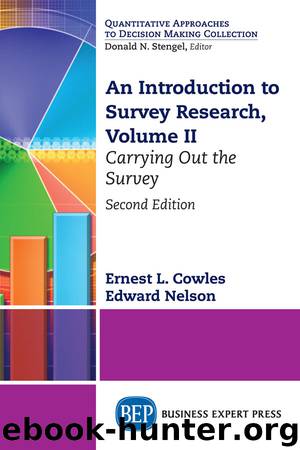An Introduction to Survey Research, Volume II by Ernest L. Cowles & Edward Nelson

Author:Ernest L. Cowles & Edward Nelson
Language: eng
Format: epub
Publisher: Business Expert Press
Published: 2019-06-07T16:00:00+00:00
Survey Panels
As mentioned in Chapter 4 (Volume I), another web-based survey option gaining popularity, particularly because of low response rates to traditional telephone surveys and the growing availability of mobile Internet accessibility, is the survey panel. A survey panel is a sample of respondents who have agreed to take part in multiple surveys over time. Within online panel research, there are two distinct types: probability-based panels and opt-in or access panels.28
Probability-based Panels
With probability-based panels, a random sample is drawn from the population of interest, and the selected individuals are contacted and solicited to join the panel. While such a probability-based sample is considered the gold standard in terms of survey panels (as with other types of survey samples), it is not without problems. As might be inferred from the discussion of online access earlier, one crucial factor with probability-based panels is that those who do not have Internet access must be provided with it. If not, then the elimination of such individuals results in a biased sample that may not reflect the target population. As mentioned earlier in this chapter, the Pew Research Center estimates 89 percent of U.S. adults self-identify as Internet users. The fact that such an online-only survey panel would be excluding roughly one-in-ten adults might be considered unimportant, but the true share of the population that will be excluded from the Web-only survey is actually larger than that estimate suggests. For in addition to respondents who are not Internet users, the Pew Research identified other problems of web panel participation in connection with its American Trends Panel (ATP).29 Some respondents invited to participate in the Pew Research Center’s ATP either did not have or were not willing to provide an e-mail address in order to facilitate participation online. In fact, a little less than half of the typical mail sample of the Pew Center’s ATP consisted of Internet users who, for one reason or another, declined to participate in the ATP via the Web, and that share likely would have been higher if researchers had not stopped inviting these respondents to join the panel partway through recruitment. In total, the weighted share of panelists in the Pew study of the ATP who took surveys by mail was around 18 percent.30
Download
This site does not store any files on its server. We only index and link to content provided by other sites. Please contact the content providers to delete copyright contents if any and email us, we'll remove relevant links or contents immediately.
Bad Blood by John Carreyrou(6552)
Rich Dad Poor Dad by Robert T. Kiyosaki(6401)
Principles: Life and Work by Ray Dalio(6209)
Playing to Win_ How Strategy Really Works by A.G. Lafley & Roger L. Martin(5916)
Management Strategies for the Cloud Revolution: How Cloud Computing Is Transforming Business and Why You Can't Afford to Be Left Behind by Charles Babcock(4525)
The Confidence Code by Katty Kay(4187)
Thinking in Bets by Annie Duke(4152)
American Kingpin by Nick Bilton(3756)
Delivering Happiness by Tony Hsieh(3365)
Project Animal Farm: An Accidental Journey into the Secret World of Farming and the Truth About Our Food by Sonia Faruqi(3177)
The Power of Habit by Charles Duhigg(3059)
The Tyranny of Metrics by Jerry Z. Muller(3000)
Brotopia by Emily Chang(3000)
Mastering Bitcoin: Programming the Open Blockchain by Andreas M. Antonopoulos(2981)
The Marketing Plan Handbook: Develop Big-Picture Marketing Plans for Pennies on the Dollar by Robert W. Bly(2975)
I Live in the Future & Here's How It Works by Nick Bilton(2935)
The Content Trap by Bharat Anand(2860)
Building a StoryBrand by Donald Miller(2841)
Applied Empathy by Michael Ventura(2839)
